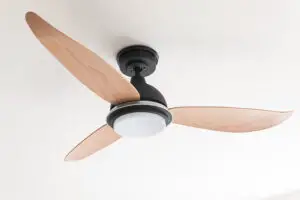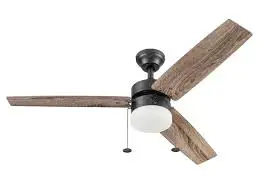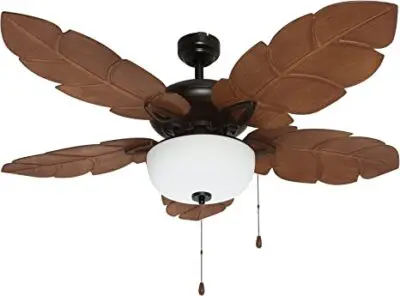Ceiling fans have been a popular addition to homes for decades; they help keep us cool during hot summer days, but they can also help save energy by circulating air and reducing the need for air conditioning. When purchasing a ceiling fan, one of the most important things to consider is the ceiling fan dimensions.
Understanding ceiling fan dimensions is critical to ensuring that you get a fan that looks not only great in your space but also provides maximum efficiency and comfort. So, let’s dive into the world of ceiling fan dimensions and explore all the important information you need to know.
What are the standard ceiling fan dimensions?

The standard ceiling fan dimensions vary depending on the fan’s size and type, but the most common size for residential use is 52 inches. A typical ceiling fan has a height of 12-18 inches from the ceiling to the bottom of the fan blades.
The blades themselves can range from 29 to 54 inches in length, with a blade pitch angle of 12-16 degrees. The fan motor housing is usually between 8 to 12 inches in height and width, with a weight ranging from 10 to 25 pounds.
Also, it’s important to keep these standard dimensions in mind when selecting the right ceiling fan for your space to ensure that it fits and operates properly.
What size ceiling fan do I need for my room?
The size of the ceiling fan you need for your room depends on the size of your room. To determine the right size, you can use a simple formula. Measure the length and width of your room in feet, and then add those two numbers together.
Next, use that sum to determine the appropriate blade span or the diameter of the circle made by the rotating blades. For example, if your room is 12 feet by 12 feet, the sum is 24, which means you would need a ceiling fan with a blade span of 44-54 inches. It’s also important to consider the ceiling height, as a room with a high ceiling will require a larger blade span to ensure proper air circulation.
Can a small ceiling fan fit in a small room?
Yes, a small ceiling fan can fit in a small room, but it’s important to make sure that the blade span is appropriate for the room’s size. For a room that is less than 100 square feet, a fan with a blade span of 29-36 inches would be appropriate.
Small ceiling fans are a great option for rooms such as small bedrooms, home offices, and even bathrooms. They can also be a good solution for rooms with low ceilings or tight spaces where a larger fan may not fit.
When selecting a small ceiling fan, make sure to choose a model with the appropriate airflow to ensure it provides adequate circulation and cooling for the space.
How low should a ceiling fan hang from the ceiling?
The height of a ceiling fan from the ceiling will depend on the height of the room and the type of ceiling fan you have. In general, a ceiling fan should hang at least 7 feet above the floor. This allows for safe operation and provides adequate clearance for the fan blades.
For rooms with low ceilings, a flush-mount ceiling fan can be installed directly against the ceiling to minimize the height. For rooms with high ceilings, a downrod can be used to extend the fan and lower it to an appropriate height.
It’s important to follow the manufacturer’s instructions for the installation of your ceiling fan to ensure proper height and safe operation.
How wide should a ceiling fan be for a large room?
The width, or blade span, of a ceiling fan for a large room, should be between 52-60 inches. For rooms larger than 400 square feet, a fan with a blade span of 60 inches or more may be necessary to ensure proper airflow and cooling.
A larger ceiling fan can also help to create a dramatic visual statement in a room with high ceilings or open spaces. It’s important to keep in mind that a fan that is too small for a large room may not provide adequate circulation, while a fan that is too large can overpower the space and create an uncomfortable amount of airflow.
When selecting a ceiling fan for a large room, make sure to choose a model that is appropriately sized for the space.
What is the blade span of a ceiling fan?

The blade span of a ceiling fan is the diameter of the circle made by the rotating fan blades. It is typically measured from the tip of one blade to the tip of the opposite blade. Blade spans can vary depending on the size and type of the fan but typically range from 29 to 60 inches.
A fan with a larger blade span can move more air and provide greater cooling power, making it a good option for large rooms or spaces with high ceilings. However, it’s important to select a blade span that is appropriate for the size of your room to ensure efficient operation and comfort.
Can a ceiling fan be too big for a room?
Yes, a ceiling fan can be too big for a room. If a fan is too large for a room, it can create an uncomfortable amount of airflow and cause the room to feel drafty or chilly. Additionally, a fan that is too big for a room can use more energy and be less efficient, as it is designed to move more air than is necessary for the space.
When selecting a ceiling fan, it’s important to consider the room’s size and choose a fan with an appropriate blade span. A fan that is appropriately sized for the room will operate more efficiently, create a comfortable amount of airflow, and help to keep energy costs low.
What is the height of a typical ceiling fan?
The height of a typical ceiling fan can vary depending on the model and design, but it is typically between 12-18 inches from the ceiling to the bottom of the fan blades. The height can be adjusted using a downrod, which is a metal rod that connects the fan motor housing to the mounting bracket.
The length of the downrod can vary depending on the height of the ceiling and the desired positioning of the fan.
Additionally, some ceiling fans can be installed flush with the ceiling, which can reduce the overall height of the fan. It’s important to consider the height of the ceiling and the desired positioning of the fan when selecting a ceiling fan to ensure that it will fit and operate properly.
What is the weight of a standard ceiling fan?
The weight of a standard ceiling fan can vary depending on the model and design, but it is typically between 10-25 pounds. The weight can be affected by factors such as the size of the fan, the type of motor and blades, and any additional features such as lighting or remote controls.
The weight of the fan is an important consideration when selecting a mounting bracket and installing the fan, as it must be able to support the weight of the fan and prevent it from falling or shaking during operation.
Also, it’s important to follow the manufacturer’s instructions for installation and ensure that the fan is securely mounted to prevent any safety hazards.
Can a ceiling fan be installed on a sloped ceiling?
Yes, a ceiling fan can be installed on a sloped ceiling using a ceiling fan sloped adapter. The adapter is a metal bracket that attaches to the ceiling and provides a level mounting surface for the fan.
It is designed to accommodate sloped ceilings of various angles, allowing the fan to hang straight and operate properly. When installing a ceiling fan on a sloped ceiling, it’s important to select a sloped adapter that is appropriate for the angle of the ceiling and the weight of the fan.
Also, it’s also important to follow the manufacturer’s instructions and ensure that the fan is securely mounted to prevent any safety hazards.
How many blades should a ceiling fan have?
The number of blades on a ceiling fan can vary, and the performance of the fan is not necessarily determined by the number of blades. The typical range is between three to five blades, but some fans can have as few as two or as many as nine blades.
The number of blades can affect the appearance of the fan, as well as the amount of air that it moves. Fans with more blades may create a smoother, more constant airflow, while fans with fewer blades may create a more turbulent airflow but may require less energy to operate.
Ultimately, the number of blades is a matter of personal preference, and the performance of the fan depends on factors such as the size and pitch of the blades, the motor power, and the overall design of the fan.
What is the difference between a 52-inch and a 56-inch ceiling fan?

The primary difference between a 52-inch and a 56-inch ceiling fan is the blade span or the diameter of the circle created by the rotating blades. A 56-inch fan will have a larger blade span than a 52-inch fan, which means that it can move more air and provide greater cooling power.
A 56-inch fan can be a good option for a larger room or a room with high ceilings, as it can help to circulate air and create a comfortable environment. However, a 56-inch fan may be too large for smaller rooms or spaces with lower ceilings, as it can create an uncomfortable amount of airflow and be less efficient.
When selecting a ceiling fan, it’s important to consider the size of the room and the appropriate blade span for efficient operation and comfort.
Can a ceiling fan have a remote control?
Yes, many ceiling fans come with remote controls or offer them as an optional accessory. A remote control allows you to adjust the fan’s speed and lighting settings from a distance without having to get up and pull chains or adjust switches.
Some remote controls also offer additional features such as timer settings, reverse airflow, and fan direction control. When selecting a ceiling fan with a remote control, it’s important to ensure that the remote is compatible with the fan and that it operates on a frequency that is not affected by interference from other devices in your home.
What is the distance between the ceiling and the fan blades?

The distance between the ceiling and the fan blades on a ceiling fan is known as the “drop” or “clearance.” This distance can vary depending on the design and mounting options of the fan. Typically, the clearance between the blades and the ceiling is between 7-14 inches, although some models may have higher or lower clearance.
The clearance between the ceiling and the fan blades is an important consideration when selecting and installing a ceiling fan. If the clearance is too low, the fan may not operate efficiently, and the airflow may be restricted, causing the fan to make noise or become unbalanced. If the clearance is too high, the fan may not provide adequate airflow or may look awkward in the room.
When installing a ceiling fan, it’s important to ensure that the clearance is appropriate for the size of the room, the height of the ceiling, and the design of the fan.
The manufacturer’s instructions should provide guidance on the appropriate clearance for the fan, as well as the necessary mounting options to achieve the desired clearance. It’s also important to ensure that the fan is securely mounted to prevent any safety hazards.
What is the maximum airflow of a ceiling fan?
The maximum airflow of a ceiling fan is typically measured in cubic feet per minute (CFM), and it represents the amount of air that the fan can move in one minute. The airflow of a ceiling fan depends on several factors, including the size and shape of the blades, the pitch or angle of the blades, the speed of the motor, and the overall design of the fan.
The airflow of a ceiling fan can range from as little as 1,000 CFM to as much as 10,000 CFM, depending on the fan’s size and design. A fan with a higher airflow rating can provide more cooling power and can be more effective at circulating air in larger rooms or spaces. However, a fan with a lower airflow rating may be sufficient for smaller rooms or spaces.
When selecting a ceiling fan based on its airflow rating, it’s important to consider the size of the room and the desired level of cooling or airflow. A fan with a high airflow rating may be more efficient in larger rooms, but it may not be necessary for smaller rooms or spaces.
It’s also important to consider the fan’s energy efficiency rating, as a fan with a high airflow rating may consume more energy than a fan with a lower airflow rating.
Furthermore, the maximum airflow of a ceiling fan is an important consideration when selecting a fan, and it depends on the size of the room, the desired level of cooling or airflow, and the fan’s energy efficiency rating.
Conclusion
If you want to know the ceiling fan dimensions you need, then you need to read what we have for you on this page. Ceiling fan dimensions are an important consideration when selecting a ceiling fan for your home or office.
The size and design of the fan can affect its performance, efficiency, and comfort. It’s important to choose a fan with the appropriate blade span, clearance, and airflow rating for the size of the room and the desired level of cooling or airflow.


